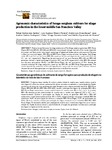Por favor, use este identificador para citar o enlazar este ítem:
http://www.alice.cnptia.embrapa.br/alice/handle/doc/970059Registro completo de metadatos
| Campo DC | Valor | Lengua/Idioma |
|---|---|---|
| dc.contributor.author | SANTOS, R. D. dos | pt_BR |
| dc.contributor.author | PEREIRA, L. G. R. | pt_BR |
| dc.contributor.author | NEVES, A. L. A. | pt_BR |
| dc.contributor.author | RODRIGUES, J. A. S. | pt_BR |
| dc.contributor.author | COSTA, C. T. F. | pt_BR |
| dc.contributor.author | OLIVEIRA, G. F. de | pt_BR |
| dc.date.accessioned | 2013-10-31T11:11:11Z | pt_BR |
| dc.date.available | 2013-10-31T11:11:11Z | pt_BR |
| dc.date.created | 2013-10-31 | pt_BR |
| dc.date.issued | 2013 | pt_BR |
| dc.identifier.citation | Acta Scientiarum. Animal Sciences, Maringá, v. 35, n. 1, p. 13-19, jan./mar. 2013. | pt_BR |
| dc.identifier.uri | http://www.alice.cnptia.embrapa.br/alice/handle/doc/970059 | pt_BR |
| dc.description | Productive performance for silage production of five forage sorghum genotypes (BRS Ponta Negra, BRS 655, BR 601, BRS 506 and BRS 610) was evaluated through the yield of dry matter, digestible dry matter, and fresh matter, plant height, percentage of lodged and broken plants, and anatomical fractions in Brazilian semi-arid region. BRS 506 and BRS Ponta Negra varieties achieved the highest fresh forage yields (89.4 and 76.2 ton. ha-1), and BRS 506, stood out for dry and digestible dry matter yield (25.2 and 12.1 ton. ha-1, respectively). Regarding the participation of the plant fractions, BRS 655 and BRS 610 genotypes showed a higher percentage of panicles (50.2 and 41.0% respectively), while BRS 506 stressed out the stem participation (84.6%), and BRS Ponta Negra, the leaf participation (17.9%). Among the materials evaluated for silage production, stood out the BRS 506 and BRS Ponta Negra genotypes. The results obtained for production of dry and digestible dry matter, and the ratio of plant fractions indicates the possible use of these genotypes on silage production in the Brazilian semiarid. | pt_BR |
| dc.language.iso | eng | eng |
| dc.rights | openAccess | eng |
| dc.subject | Animal producrion | pt_BR |
| dc.subject | Dry matter | pt_BR |
| dc.title | Agronomic characteristics of forage sorghum cultivars for silage production in the lower middle San Francisco Valley. | pt_BR |
| dc.type | Artigo de periódico | pt_BR |
| dc.date.updated | 2013-10-31T11:11:11Z | pt_BR |
| dc.subject.thesagro | Forragem | pt_BR |
| dc.subject.thesagro | Matéria seca | pt_BR |
| dc.subject.thesagro | Nutrição | pt_BR |
| dc.subject.thesagro | Ruminante | pt_BR |
| dc.subject.thesagro | Produção animal | pt_BR |
| dc.subject.thesagro | Pastagem | pt_BR |
| dc.subject.thesagro | Sorghum Bicolor | pt_BR |
| dc.subject.nalthesaurus | Forage | pt_BR |
| riaa.ainfo.id | 970059 | pt_BR |
| riaa.ainfo.lastupdate | 2013-10-31 | pt_BR |
| dc.identifier.doi | 10.4025/actascianimsci.v35i1.13072 | eng |
| dc.contributor.institution | RAFAEL DANTAS DOS SANTOS, CPATSA | pt_BR |
| dc.contributor.institution | LUIZ GUSTAVO RIBEIRO PEREIRA, CNPGL | eng |
| dc.contributor.institution | ANDRE LUIS ALVES NEVES, CNPGL | eng |
| dc.contributor.institution | JOSE AVELINO SANTOS RODRIGUES, CNPMS | eng |
| dc.contributor.institution | CLEBER THIAGO FERREIRA COSTA, UFRPE | eng |
| dc.contributor.institution | GETÚLIO FIGUEIREDO DE OLIVEIRA, Universidade Federal de Sergipe. | eng |
| Aparece en las colecciones: | Artigo em periódico indexado (CPATSA)  | |
Ficheros en este ítem:
| Fichero | Descripción | Tamaño | Formato | |
|---|---|---|---|---|
| Rafael2013.pdf | 573,79 kB | Adobe PDF |  Visualizar/Abrir |









